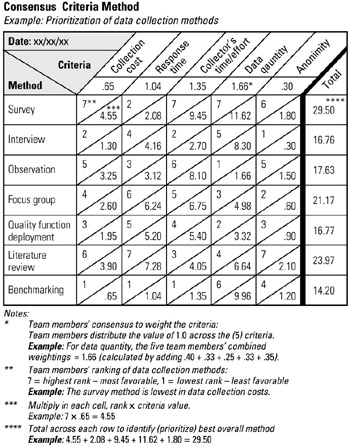Tool 142: Prioritization Matrix-Consensus
| AKA | N/A |
| Classification | Evaluating/Selecting (ES) |
Tool description
First introduced by T. L. Saaty (1988), prioritization matrices are used to prioritize among particular projects, issues, or options on the basis of team-established, weighted criteria. Three variations of matrix construction are used: (A) the full analytical criteria method, (B) the consensus criteria method, and (C) the combination interrelationship digraph/matrix method. The consensus criteria method is used when a team experiences difficulty in arriving at a decision.
Typical application
-
To apply team consensus criteria to select and decide on further action.
-
To prioritize among activities, issues, or options based on weighted criteria.
-
To select and prioritize recommended change options.
-
To allocate limited resoures to the most important option
Problem-solving phase
| → | Select and define problem or opportunity |
| Identify and analyze causes or potential change | |
| Develop and plan possible solutions or change | |
| → | Implement and evaluate solution or change |
| Measure and report solution or change results | |
| Recognize and reward team efforts |
Typically used by
| Research/statistics | |
| Creativity/innovation | |
| 5 | Engineering |
| 1 | Project management |
| 3 | Manufacturing |
| Marketing/sales | |
| Administration/documentation | |
| 4 | Servicing/support |
| Customer/quality metrics | |
| 2 | Change management |
before
-
Tree Diagram
-
Consensus Decision Making
-
Task Analysis
-
Information Needs Analysis
-
Nominal Group Technique (NGT)
after
-
Action Plan
-
Objectives Matrix (OMAX)
-
Responsibility Matrix
-
Process Mapping
-
Resource Requirements Matrix
Notes and key points
-
The consensus criteria method
This method is less difficult and more flexible for a team to use when prioritizing. Simple consensus for criteria weighting and ranking techniques can be used.
-
Refer to Thomas L. Saaty's book Decision Making for Leaders, University of Pittsburgh (1988) for additional information on prioritization processes.
Step-by-step procedure
-
STEP 1 The team decides what project, issue, or option needs to be prioritized.
-
STEP 2 Select a particular prioritization matrix method to be constructed. There are three alternatives:
-
Full analytical criteria method
-
Consensus criteria method
-
Combination ID/matrix method
-
-
STEP 3 The team agrees to prioritize data collection methods and establishes a list of criteria. See example Consensus Criteria Method.
-
STEP 4 Next, the team ranks data collection methods as shown in the matrix.
-
STEP 5 All matrix cells are calculated and row totals indicated as shown in the matrix.
-
STEP 6 Check calculations and date the matrix.
Example of tool application

EAN: 2147483647
Pages: 326
- Step 2.1 Use the OpenSSH Tool Suite to Replace Clear-Text Programs
- Step 3.1 Use PuTTY as a Graphical Replacement for telnet and rlogin
- Step 3.2 Use PuTTY / plink as a Command Line Replacement for telnet / rlogin
- Step 3.3 Use WinSCP as a Graphical Replacement for FTP and RCP
- Step 4.7 Using Public Key Authentication for Automated File Transfers